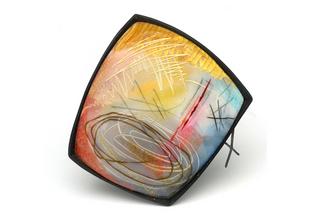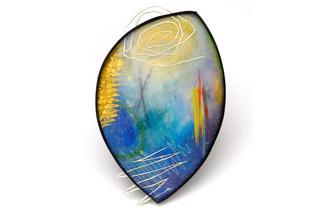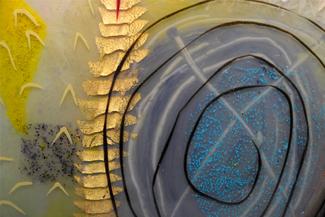New Translucent Techniques in Polymer Clay
Learn how to layer translucent polymer clay to produce a rich depth of surface using polymer heat-set paints, simple casework, gold leaf and powder inclusions, carving, sanding and buffing. Each student will apply the techniques learned in this workshop to complete a brooch or pendant. Kathleen will present basic artistic principles to aid students in making decisions as they work with this involved technique.
This workshop is for intermediate to advanced students as some experience with polymer tools is required and basic techniques are used, but not taught in this class. This workshop is not appropriate for beginners.
All polymer clay used for this workshop has been generously provided by Polyform Products.
Meet the instructor

Ceramic artist Kathleen Dustin, M.F.A., has been working with polymer clay since the early 1980s, developing many of her own techniques because it was a material with no history as a fine art or fine craft medium. She is a member and juror of the League of New Hampshire Craftsmen, the oldest professional craft organization in the United States, and has been a juror for numerous national shows. Kathleen maintains a busy juried show schedule throughout the year and teaches workshops around North America and in Europe.
Materials & Tools
There is a $14 materials fee for this course that is payable to the instructor on the first day of class. The materials kit for this workshop includes the use of Genesis Paints, a paint palette, composition foil, and a carving blade.
All polymer clay used for this workshop has been generously provided by Polyform Products.
- Work surface
- Pasta machine
- Polymer tools you normally use including thin flexi slicing blade, xacto knife, a pin tool
- a small tile to bake on
- 2 Fine grit sanding sponges or 220 wet/dry sandpaper. Then 4 or 5 grits of wet/dry sandpaper stepping up to 1000 grit. (For example: 400, 600, 800, 1000)
- Cyanoacrylate glue, both gel and liquid (Loctite brand is recommended)
- Set of 3-4 nice craft paint brushes – very fine to medium in size.
- 1 or 2 of small jars of fine glitter or embossing powder, any colors (NOT Pearlex powders which are too fine).
- Clear kitchen wrap, like Saran Wrap.
- 4 or 5 sheets of white paper (like computer printer paper).
- Large simple shape cutters in shapes you like for cutting pendant or brooch.
- A few images of abstract or loose painting to use for inspiration.
- Only if you have one, bring an embossing heat gun - a few will be needed for the class



